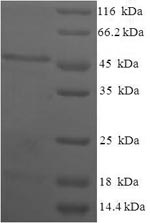The recombinant Human HSD17B11 was expressed with the amino acid range of 20-300. The theoretical molecular weight of the HSD17B11 protein is 46.8 kDa. Expression of this HSD17B11 protein is conducted in e.coli. The N-terminal 6xHis-SUMO tag was fused into the coding gene segment of HSD17B11, making it easier to detect and purify the HSD17B11 recombinant protein in the later stages of expression and purification.
Human Estradiol 17-beta-dehydrogenase 11 (HSD17B11) is an enzyme involved in the conversion of estrone to estradiol, a key step in estrogen biosynthesis. HSD17B11's main role in steroid hormone metabolism positions it as a significant player in endocrine regulation. In medical and reproductive research, studying HSD17B11 provides insights into hormone-related conditions and potential therapeutic targets for estrogen-dependent diseases. Its involvement in cancer progression implicates HSD17B11 in oncology research, offering avenues for targeted therapies. Investigating HSD17B11 spans endocrinology, reproductive medicine, and oncology, contributing to a comprehensive understanding of hormone dynamics and presenting opportunities for developing therapeutic strategies for hormone-related disorders and cancers.






